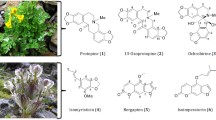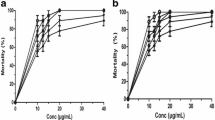Abstract
Microbial and helminthes infections are the most common health problems in India; in developing countries they pose a large treat to public. These infections can affect most population in endemic areas with major economic and social consequences. In vitro antibacterial activity of a phytoconstituent, polyprenol isolated from the leaves of Kirganelia reticulata was screened against Gram-negative and Gram-positive bacteria. The minimum inhibitory concentration (MIC) and minimum bactericidal concentrations (MBC) of the purified antibacterial agent were also determined. The present study also undertook evaluation of antihelminthic activity of polyprenol at different concentrations using Pheretima posthuma as a test worm. The bioassay involved the determination of paralysis time and death time of the worm. The polyprenol showed antibacterial activity against different bacterial strains with MIC 6.25–25.0 mgml−1 and MBC 12.50–25.0 mgml−1, and possesses better glucosamine-6-phosphate synthase inhibition in molecular docking studies with minimum docking energy and better ligand efficiency when compared to the standard. The antihelminthic results of the present study indicated that polyprenol significantly demonstrated paralysis and caused death of worm in dose-dependent manner; showing comparable results with the standard in docking process. Hence, the isolated compound polyprenol is suggestive of being a good antibacterial and antihelminthic agent.



Similar content being viewed by others
References
Abu-Shanab B, Abu-Hijleh A, Adwan G, Jarrar N et al (2006) Antibacterial activity of four plant extracts used in palestine in folkloric medicine against methicillin-resistant Staphylococcus aureus. Turk J Biol 30:195–198
Ajaiyeoba EO, Onocha PA, Olarenwaju OT (2001) In vitro anthelmintic properties of Buchholzia coriaceae and Gynandropsis gynandra extract. Pharm Biol 39:217–220
Akinyemi KO, Oladapo O, Okwara CE, Ibe CC, Fasure KA (2005) Screening of crude extracts of six medicinal plants used in southwest Nigerian unorthodox medicine for antimethicillin resistant Staphylococcus aureus activity. BMC Complement Altern Med 5:6
Anderson RJ, Bendell DJ, Hooper M, Cairns D, Mackay SP, Hiremath SP, Jivanagi AS, Badami S, Biradar JS, Townson S (2001) Potential transition state phosphoramidate inhibitors of betatubulin as antifilarial agents. J Pharm Pharmacol 53(1):89–94
Aneja KR (2003) Experiments in microbiology, plant pathology and biotechnology, 4th edn. New Age International Ltd., New Delhi
Atata R, Sani A, Ajewole SM (2003) Effect of stem back extracts of Enantia chloranta on some clinical isolates. Biokemistri 15(2):84–92
Bates CJ, Pasternak CA (1965) Further studies on the regulation of amino sugar metabolism in Bacillus subtilis. Biochem J 96:147–154
Bates CJ, Adams WR, Handschumacher RE (1966) Control of the formation of uridine diphospho-N-acetyl-hexosamine and glycoprotein synthesis in rat liver. J Biol Chem 241:1705–1712
Binkowski TA, Naghibzadeg S, Liang J (2003) CASTp computed atlas of surface topography of proteins. Nucleic Acid Res 31:3352–3355
Bueding E (1969) Some biochemical effects of anthelmintic drugs. Biochem Pharmacol 18:1541–1547
Bugno A, Aparecida M, Adriana N, Almodóvar AB, Pereira TC, Auricchio MT (2007) Antimicrobial efficacy of Curcuma zedoaria extract as assessed by linear regression compared with commercial mouthrinses. Braz J Microbiol 38:440–445
Chaturvedi M, Dwivedi S, Dwivedi A, Barpete PK, Sachan R (2009) Formulation and evaluation of polyherbal anthelminthic preparation. Ethnobot Leafl 13:329–331
Chen C-Y, Wang Y-D (2010) Polyprenol from the whole plants of Leucaena leucocephala. J Environ Prot 1:70–72
Chmara H, Borowski E (1986) Bacteriolytic effect of cessation of glucosamine supply, induced by specific inhibition of glucosamine-6-phosphate synthetase. Acta Microbiol Pol 35:15–27
Chmara H, Zahner H, Borowski E, Milewski S (1984) Inhibition of glucosamine-6-phosphate synthetase from bacteria by anticapsin. J Antibiot (Tokyo) 37:652–658
Coulaud JP, Rossignol JF (1984) Albendazole: a new single dose anthelmintic. Study in (1455) patients. Acta Trop 41(1):87–90
Dash GK, Suresh P, Kar DM, Ganpaty S, Panda SB (2002) Evaluation of Evolvulus alsinoids Linn for anthelmintic and antimicrobial activities. J Nat Rem 2:182–185
Direkbusarakom S, Ezura Y, Herunsalee A, Yoshimizu M (1998) Efficacy of Thai traditional herb extracts against fish and shrimp pathogenic bacteria. Fish Pathol 33:437–441
Gasteiger J, Marsili M (1980) Iterative partial equalization of orbital electronegativity—a rapid access to atomic charges. Tetrahedron 36:3219–3288
Ghani A (2003) Medicinal plants of Bangladesh with chemical constituents and uses, 2nd edn. Asiatic Society of Bangladesh, Dhaka 345
Ghose AK, Crippen GM (1987) Atomic physicochemical parameters for threedimensional-structure-directed quantitative structure-activity relationships. 2. Modelingdispersive and hydrophobic interactions. J Chem Inf Comput Sci 27:21–35
Henriquez FL, Ingram PR, Muench SP, Rice DW, Roberts CW (2008) Molecular basis for resistance of acanthamoeba tubulins to all major classes of antitubulin compounds. Antimicrob Agents Chemother 52(3):1133–1135
Hugdahl JD, Morejohn LC (1993) Rapid and reversible high-affinity binding of the dinitroaniline herbicide oryzalin to tubulin from Zea mays L. Plant Physiol 102(3):725–740
Imada Y, Nozaki F, Kawashima M, Yoned A (1977) Regulation of glucosamine utilization in Staphylococcus aureus and Escherichia coli. J Gen Microbiol 100:329–337
Isupov MN, Obmolova G, Butterworth S, Badet-Denisot MA, Badet B, Polikarpov I, Littlechild JA (1996) Substrate binding is required for assembly of the active conformation of the catalytic site in Ntn amidotransferases: evidence from the 1.8 Å crystal structure of the glutaminase domain of glucosamine 6-phosphate synthase. Structure 4:801–810
Jain ML, Jain SR (1972) Therapeutic utility of Ocimum basilicum var. album. Plant Med 22:66–70
Khan AV, Parveen G, Alam MM, Singh VK (2002) Ethnomedicinal uses of Neem in rural areas of Uttar Pradesh, India. Ethnomed Pharmacog (Sci. Tech. Pub. USA). II Rec. Prog. Med. Plants. USA. 319-326
Khanna V, Ranganathan S (2011) In silico approach to screen compounds active against parasitic nematodes of major socioeconomic importance. BMC Bioinformatics 12(13):S25
Kopp SR, Coleman GT, Traub RJ, McCarthy JS, Kotze AC (2009) Acetylcholine receptor subunit genes from Ancylostoma caninum: altered transcription patterns associated with pyrantel resistance. Int J Parasitol 39:435–441
Kosulina TP, Kaigorodova EA, Kul’nevich VG, Sapunov AY, Govorova SA (1997) Synthesis and study of antihelminthic activity of new 2-pyridone derivatives. Pharm Chem J 31(4):191–193
Kumar S, Deshmukh RR, Kumar D, Lokhande PD et al (2008) Antidiabetic potential of Phyllanthus reticulatus in alloxan-induced diabetic mice. Fitoterapia 79:21–23
Marrero-Ponce Y, Castillo-Garit JA, Olazabal E, Serrano HS, Morales A, Castanedo N, Ibarra-Velarde F, Huesca-Guillen A, Jorge E, del Valle A et al (2004) TOMOCOMDCARDD, a novel approach for computer-aided ‘rational’ drug design: I. Theoretical and experimental assessment of a promising method for computational screening and in silico design of new anthelmintic compounds. J Comput Aided Mol Des 18(10):615–634
Martin RJ (1997) Mode of action of anthelmintic drugs. Vet J 154:11–34
Merino G, Jonker JW, Wagenaar E, Pulido MM, Molina AJ, Alvarez AI, Schinkel AH (2005) Transport of anthelmintic benzimidazole drugs by breast cancer resistance protein (BCRP/ABCG2). Drug Metab Dispos 33(5):614–618
Milewski S, Chmara H, Borowski E (1986) Antibiotic tetaine—a selective inhibitor of chitin and mannoprotein biosynthesis in Candida albicans. Arch Microbiol 145:234–240
Nair R, Kalariya T, Chanda S (2005) Antibacterial activity of some selected Indian medicinal flora. Turk J Biol 29:41–47
Nandkarni KM (1982) Indian Materia Medica, Vol. 2, Publisher, City, 948, The Wealth of India (2005), National Institute of Science Communication and Information Resources, vol 7. Council of Scientific and Industrial Research, New Delhi, p 34
National committee for clinical laboratory standards (2000) Methods for dilution, antimicrobial susceptibility tests for bacteria that grow aerobically, 5th edn. NCCLS, Wayne
Nitha B, Meera CR, Janardhanan KK (2007) Anti-inflammatory and antitumour activities of cultured mycelium of morel mushroom, Morchella esculenta. Curr Sci 92(25):235–239
Omulokoli E, Chhabra SC, Khan B (1997) Antiplasmodial activity of four Kenyan medicinal plants. J Ethnopharmacol 56:133–137
Renuka J, Alam S, Jain SC, Rekha A (1998) Phytochemistry and bioactivity of Kirganelia reticulate. J Med Aromat Plant Sci 20:740–741
Shahidi Bonjar GH (2004) Evaluation of antibacterial properties of Iranian medicinal plants against Micrococcus aureus, Serratia marcescens, Klebsiella pneunomiae and Bordella bronchoseptica. Asian J Sci 3(1):82–86
Shruthi SD, Padmalatha Rai S, Ramachandra YL (2010a) In vitro antibacterial activities of Kirganelia Reticulata Baill. Against methicillin-resistant Staphylococcus Aureus. Pharmacophore 1(2):123–131
Shruthi SD, Padmalatha Rai S, Ramachandra YL, Veena Shetty A (2010) Antibacterial potential of leaf extracts from Kirganelia reticulata Baill. Int J Pharm Res Dev 2(6)
Suresh PGK, Kar DM, Ganpaty S, Panda SB (2002) Evaluation of Evolvulus alsinoids Linn. for anthelmintic and antimicrobial activities. J Nat Rem 2:182–185
The Wealth of India (2005) National Institute of Science Communication and Information Resources, vol 7. Council of Scientific and Industrial Research, New Delhi, p 34
Vidya SM, Krishna V, Manjunatha BK, Rajesh KP, Bharath BR, Manjunatha H (2011) Antibacterial and molecular docking studies of entagenic acid, a bioactive principle from seed kernel of Entada pursaetha DC. Med Chem Res. doi:10.1007/s00044-011-9614-4
Vigar Z (1984) Atlas of medical parasitology, 2nd edn. P.G. Publication House, Singapore, pp 216–217
Wampande EM, Richard McIntosh J, Lubega GW (2007) Classical ligands interact with native and recombinant tubulin from Onchocerca volvulus with similar rank order of magnitude. Protein Expr Purif 55(2):236–245
Williamson SM, Robertson AP, Brown L, Williams T, Woods DJ, Martin RJ, Sattelle DB, Wolstenholme AJ (2009) The nicotinic acetylcholine receptors of the parasitic nematode Ascaris suum: formation of two distinct drug targets by varying the relative expression levels of two subunits. PLoS Pathog 5(7):1–11
Wojciechowski M, Milewski S, Mazerski J, Borowski E (2005) Glucosamine-6-phosphate synthase, a novel target for antifungal agents. Molecular modelling studies in drug design. Acta Biochim Pol 52(3):647–653
Yoganarasimhan SN (1996) Medicinal plants of india, vol 1. Interline Publishing Pvt. Ltd., Bangalore 275
Author information
Authors and Affiliations
Corresponding author
Rights and permissions
About this article
Cite this article
Shruthi, S.D., Padmalatha Rai, S. & Ramachandra, Y.L. Isolation, characterization, antibacterial, antihelminthic, and in silico studies of polyprenol from Kirganelia reticulata Baill. Med Chem Res 22, 2938–2945 (2013). https://doi.org/10.1007/s00044-012-0295-4
Received:
Accepted:
Published:
Issue Date:
DOI: https://doi.org/10.1007/s00044-012-0295-4




